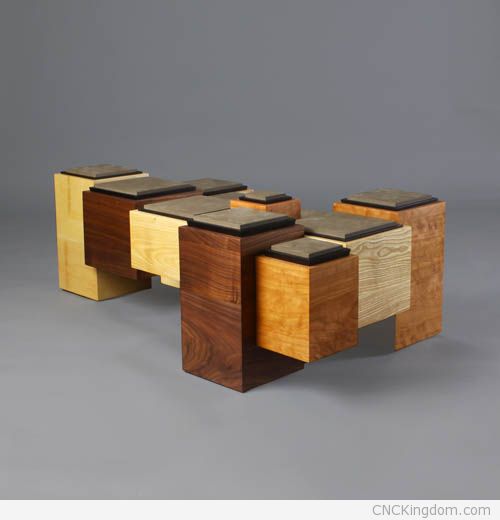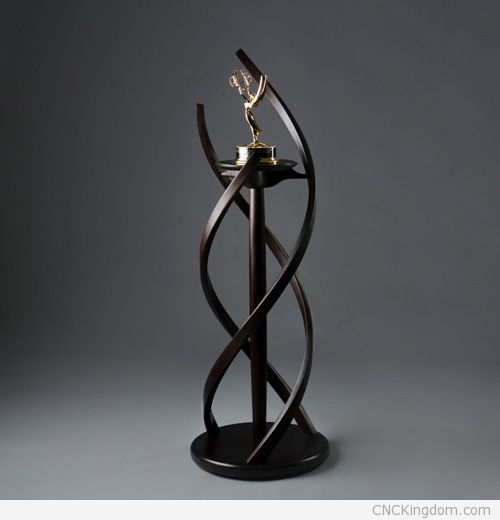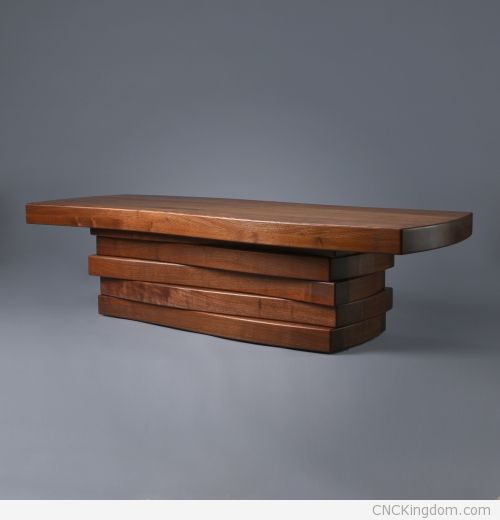Mark Whitley Owner/Artist at Mark Whitley Limited Edition Furniture (USA)
It’s astounding how many shapes and uses a simple material as wood has – I love working with it and although I use machines for my cutting – I can completely understand the artistry that’s required to make pieces such as what Mark produces in his shop.
Key takeaways
- Find buyers for your work before you make them.
- Attend trade shows to find clients.
- Be, Do, Have. If you just be who you are, and do what it is that you do, you will have the things you need to make it through this world.
You can find Mark’s company at http://mwhitley.com.
You’ve won over a dozen awards for your awesome woodworking products… do you design with specific awards in mind or do you just submit work you are proud of in the hopes that others find them as aspiring as you do?
 I’ve never considered an award to be the ultimate prize. I enter shows planning to win, and then create something new that pushes my skill set and vision.
I’ve never considered an award to be the ultimate prize. I enter shows planning to win, and then create something new that pushes my skill set and vision.
My satisfaction comes from watching the vision in my head appear on the bench as a finished piece. If others find my work inspiring, or it gains notice from the judges, that is just icing on the cake.
Can you give me an idea of the process behind getting and completing a commissioned piece? You’ve done hundreds of them so I’m sure you have some great advice for people interested in getting this kind of work. What percentage of it is referrals vs you calling-up new business or people dropping in?
Most of my pieces are sold before I create them. I find clients at the three shows I do per year, and nurture the relationships with those clients into completed commissions. Most of the time, I am approached with the function needed by the client; a table for 10, or a desk to hold this or that, or a cabinet to display a certain piece of glass. I then visit the space if possible and create a quick sketch on the spot.
Many times that is the only drafting that takes place during the project. Once the vision is agreed upon, we find a price both parties can live with. My studio is not very accessible, so there’s no drop-in business. My work comes from meeting people in person, or from time to time, referrals.

Your Mambo Chair and Rocker are just awesome… incredibly elegant and beautiful. How long did it take to design, cut and build it? Do you do all the work yourself including the leather upholstering?
Those chairs were one-offs based on the “S” on Superman’s shirt. They probably took a couple of months to create. Like lots of designs, they have areas that could be improved, but I took them both through to the end including the upholstery work.

What tools do you use to create your furniture and projects with? Have you ever considered using CNC machines like a CNC table router or laser cutter to augment your other tools?
I have a decent complement of tools, a big Sawstop table saw, a nice old DeWalt radial arm saw from the 60’s, a big old Powermatic planer, a horizontal mortiser, a Minimax band saw and lathe, other big tools, and piles of handplanes, scrapers, chisels, and the like.
My favorite tools are some old Witherby sash chisels and Flexcut gouges. I’ve outsourced CNC equipment only once to cut out sections of a huge oval conference table. The blanks were too big to cut on the band saw, and in that situation, the CNC mill was the best.

Where do you get much of your ideas about furniture? For instance, your Emmy Award Stand looks perfect with the award on it while your Sculpture Stand makes me think of an octopus! Do you just work off sketches or do you actually use any CAD type programs to help bring your ideas to life before cutting into wood?
The Emmy Award Stand is simply based on the Emmy and the helical twist of the award. The Sculpture Stand to me is more like a rocket ship getting ready to launch. I just see the designs in my head, and sketch with a Sharpie or a pencil. I only use measured sketches if a certain overall measurement is really critical.
I’ve never used any sort of CAD program to design. For me, it is more efficient to just build my visions than to draw them. If the client needs to see what it will look like, I’ll do a sketch. The finished piece inevitably changes at the bench. There are details that can’t be known on paper. The wood, its grain and movement, and a thousand other variables change as the project progresses.

What types of wood do you prefer using for your work and how important is finishing for your projects?
My favorite wood is Kentucky Black Walnut. It is beautiful, multi-tonal, good to the chisel, and only gets better with age. I also enjoy working mahogany, black cherry, ash, and maple. Finishing is half of the project. I start the finishing process right after I cut out the basic pieces. The smoothness, the feel, the sheen; it is all of the utmost importance to me.

What advice would you give to somebody interested in opening their own custom wood shop? Is it an easy road or does it take some time to build-up a client base that’s willing to pay for your artistry?
It is certainly not an easy road, but an amazingly fulfilling life if you have something to say through your work. For me, each project is an opportunity to add beauty to the world, to treasure the resources I have to work with, to be a good steward of the talents I have been given, and to make something that a client can bring into their home and live with and enjoy for years to come.
I’ve been a pro for 14 years, but was building since I was 4 years old. It took the first 8 or 9 years to start making a decent living. It can never be about the money. Being an artist is a lifestyle, it’s a calling of sorts. It is what you do because you have to do it to be fulfilled.

I’ve always lived by principles told to me in a conversation with an old gentleman on the street while I was in college. Be, Do, Have. If you just be who you are, and do what it is that you do, you will have the things you need to make it through this world. These words take away all of the excuses that can be made about not having good enough tools, or a big enough studio, or whatever seems to stand in your way. Where there is will, there is always a way.
